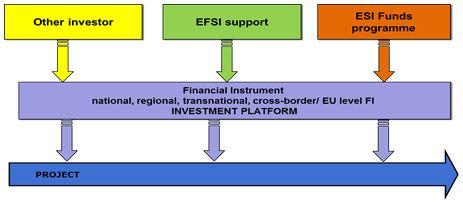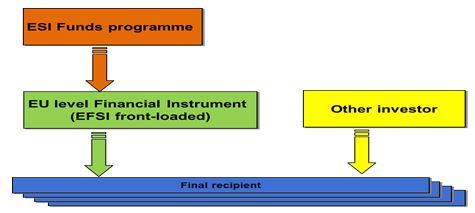Questions and answers on combining European Structural and Investment (ESI) Funds with the Investment Plan’s European Fund for Strategic Investments (EFSI) following publication of guidelines
The European Structural and Investment Funds (ESI Funds) are important contributors to the EU goals of smart, sustainable and inclusive growth. Over the 2014-2020 period, €454 billion will be invested in 500 programmes and targeted at strategic, growth-generating areas, primarily in Research, Development & Innovation, support to SMEs, the low-carbon economy, and Information and Communication Technologies.
The ESI Funds are delivered through nationally co-financed multiannual programmes, approved by the Commission and implemented by Member States and their regions under shared management. Local authorities are responsible for selecting, implementing and monitoring projects supported by ESI Funds.
The reformed framework of ESI Funds for 2014-2020 includes an enlarged scope for the use of financial instruments rather than only grants.
What is the European Fund for Strategic Investments (EFSI)?
The European Fund for Strategic Investments (EFSI) is at the heart of the Investment Plan for Europe. The European Commission and the European Investment Bank (EIB) Group launched the EFSI to help overcome the investment gap in the EU by mobilising private financing for strategic investments.
With EFSI support, the EIB Group provides financing for economically viable projects, including projects with a higher risk profile than ordinary EIB activities. Emphasis is put on the following key sectors: (i) transport, energy and the digital economy; (ii) environment and resource efficiency; (iii) human capital, culture and health; (iv) research, development and innovation; (v) support to SMEs and Mid-Caps.
The EFSI Regulation offers the possibility to finance Investment Platforms, to channel a financial contribution to a number of investment projects with a thematic or geographic focus, as well as operations with National Promotional Banks (NPBs).
What are the main differences between the European Structural and Investment Funds and the European Fund for Strategic Investments (EFSI)?
The risk profile and criteria are different. The structural funds can finance projects via grants and financial instruments and are implemented in a decentralised way by Managing authorities in the Member States. The EFSI provides risk financing instruments via the European Investment Bank.
What is the advantage of combining EFSI with ESI Funds?
Strategic combination of ESI Funds and the EFSI can help in the collective and coordinated efforts to tackle the drop in investment across Europe or in a particular region.
ESI Funds and the EFSI can mobilise additional investments by complementing each other and optimising the additionality of the investments. These funds have been designed in a different way but are complementary in terms of rationale, design, and legislative framework. They reinforce each other.
They can be combined in a number of ways, depending on the investment in question. The combination of ESI Funds and EFSI may be particularly interesting in certain countries or sectors, where the structural funds offer wide opportunities and where the EFSI on its own has not yet been fully mobilised.
Any project that is economically viable, has a potential to benefit growth and jobs in the EU and is in line with EU priorities for investments may be eligible for funding from both the EFSI and the ESI Funds. Project promoters should make use of the Advisory Hub and contact the EIB to find out if and how they can combine the funds.
What are the different ways ESI Funds can be combined with the EFSI?
ESI Funds can be combined with the EFSI in different ways. For a full explanation of the various combinations identified so far, please see the brochure. Here is an overview:
1 – Combining ESI Funds with the EFSI at project level:

2: Combining ESI Funds with the EFSI at project level through a financial instrument:



3 – Combining ESI Funds with the EFSI for SME financing using EFSI front-loaded, EU-level financial instruments providing guarantees to intermediaries.

Can ESI Funds contribute to the EFSI? Can the EFSI be used as national co-financing in an ESI Funds programme?
ESI Funds programme resources cannot be transferred directly to the EFSI. Given its nature and structure, EFSI support to a project cannot count as national co-financing of an ESI Funds programme.
However, national co-financing of an ESI Funds programme could still be provided through another EIB/EIF financial product, either through a Structural Programme Loan or through intervention at project level.
It is also possible that, under certain circumstances, any additional resources leveraged and triggered by the combined ESI Funds and EFSI interventions could be treated as national co-financing for the ESI Funds programme.
Who decides whether projects can receive EFSI financing or ESI funds? What is the approval process?
More information on the EFSI project selection process can be found here, and on accessing ESI Funds here.
Project promoters should contact the European Investment Advisory Hub for more information.
How do State aid rules apply when combining ESI Funds with the EFSI?
EU State aid rules go hand in hand with the Investment Plan’s objective of addressing market failures and mobilising private investment. ESI Funds provided to businesses, unless granted on market terms, may entail State aid, which is subject to EU State aid rules. The EFSI does not constitute State aid and is not subject to EU State aid rules.
The Commission will assess ESI Funds entailing State aid on the basis of its modernised State aid framework. To facilitate the deployment of the EFSI, the Commission will assess the compliance of ESI Funds with State aid rules as a matter of priority and give it fast-track treatment. The Commission aims to complete its assessment within six weeks of receiving the complete notification from the Member State.
Where can project promoters get help in shaping their proposals?
Project promoters should make full use of the European Investment Advisory Hub which is the gateway to technical and administrative investment advice and support. Designed jointly by the European Commission and the European Investment Bank, the Hub helps public authorities and project promoters identify, prioritise, prepare, structure and implement strategic projects and make more efficient use of EU funds by mobilising private capital. Part of this one-stop-shop is “fi-compass”, an advisory service on financial instruments for ESI Funds.
Furthermore, the European Investment Project Portal (EIPP) is a brand new web portal enabling EU-based project promoters – public or private – to reach potential investors worldwide. Hosted by the European Commission, this portal will help promoters access a large network of investors, consultants and advisory services that can help them structure their project and finance it.
Compliments of the European Commission
![European American Chamber of Commerce New York [EACCNY] | Your Partner for Transatlantic Business Resources](https://eaccny.com/wp-content/uploads/2020/06/eaccny-logo.png)